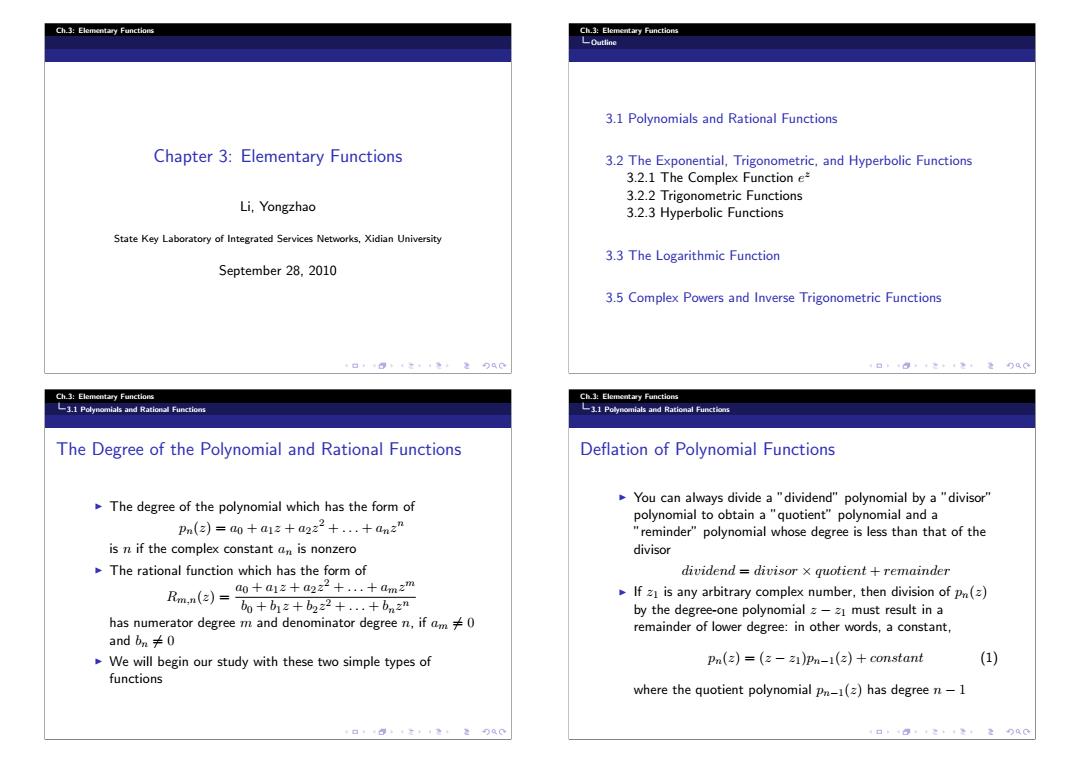正在加载图片...

Ch.3:Elementary Functions Ch.3:Elementary Functions LOutline 3.1 Polynomials and Rational Functions Chapter 3:Elementary Functions 3.2 The Exponential,Trigonometric,and Hyperbolic Functions 3.2.1 The Complex Function e* 3.2.2 Trigonometric Functions Li,Yongzhao 3.2.3 Hyperbolic Functions State Key Laboratory of Integrated Services Networks,Xidian University 3.3 The Logarithmic Function September 28,2010 3.5 Complex Powers and Inverse Trigonometric Functions Ch.3:Elementary Functions Ch.3:Elementary Functions 3.1 Polynomials and Rationol Functions 3.1 Polynomials and Rational Functions The Degree of the Polynomial and Rational Functions Deflation of Polynomial Functions The degree of the polynomial which has the form of You can always divide a"dividend"polynomial by a "divisor" pn(z)=a0+a12+a222+..+an2n polynomial to obtain a "quotient"polynomial and a "reminder"polynomial whose degree is less than that of the is n if the complex constant an is nonzero divisor The rational function which has the form of dividend=divisor x quotient +remainder R0-器 If z1 is any arbitrary complex number,then division of pn(z) by the degree-one polynomial z-z1 must result in a has numerator degree m and denominator degree n,if am0 remainder of lower degree:in other words,a constant, and bn≠0 We will begin our study with these two simple types of Pn(z)=(z-z1)pn-1(z)+constant (1) functions where the quotient polynomial pn-1(z)has degree n-1Ch.3: Elementary Functions Chapter 3: Elementary Functions Li, Yongzhao State Key Laboratory of Integrated Services Networks, Xidian University September 28, 2010 Ch.3: Elementary Functions Outline 3.1 Polynomials and Rational Functions 3.2 The Exponential, Trigonometric, and Hyperbolic Functions 3.2.1 The Complex Function ez 3.2.2 Trigonometric Functions 3.2.3 Hyperbolic Functions 3.3 The Logarithmic Function 3.5 Complex Powers and Inverse Trigonometric Functions Ch.3: Elementary Functions 3.1 Polynomials and Rational Functions The Degree of the Polynomial and Rational Functions The degree of the polynomial which has the form of pn(z) = a0 + a1z + a2z2 + ... + anzn is n if the complex constant an is nonzero The rational function which has the form of Rm,n(z) = a0 + a1z + a2z2 + ... + amzm b0 + b1z + b2z2 + ... + bnzn has numerator degree m and denominator degree n, if am = 0 and bn = 0 We will begin our study with these two simple types of functions Ch.3: Elementary Functions 3.1 Polynomials and Rational Functions Deflation of Polynomial Functions You can always divide a ”dividend” polynomial by a ”divisor” polynomial to obtain a ”quotient” polynomial and a ”reminder” polynomial whose degree is less than that of the divisor dividend = divisor × quotient + remainder If z1 is any arbitrary complex number, then division of pn(z) by the degree-one polynomial z − z1 must result in a remainder of lower degree: in other words, a constant, pn(z)=(z − z1)pn−1(z) + constant (1) where the quotient polynomial pn−1(z) has degree n − 1�������